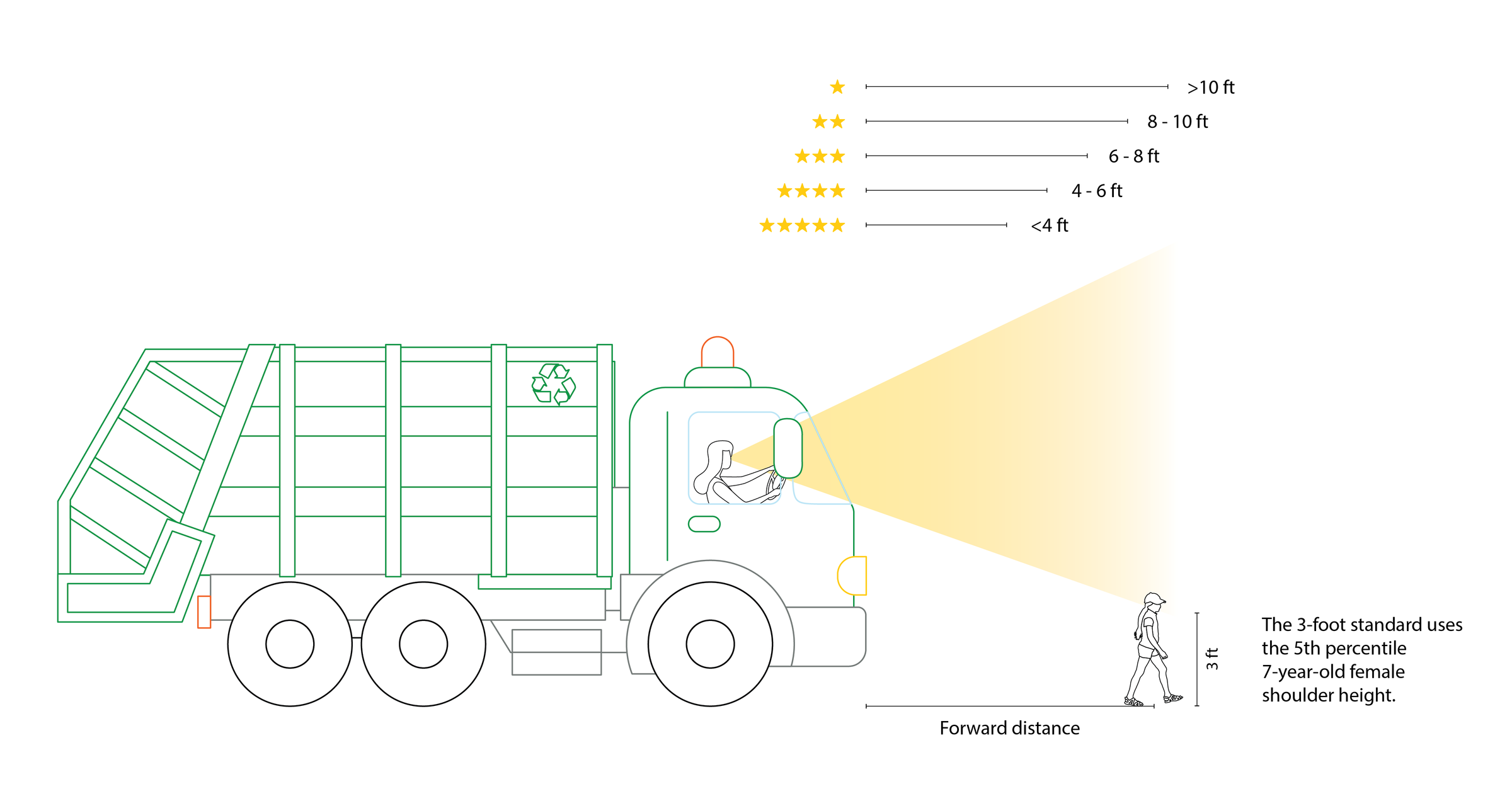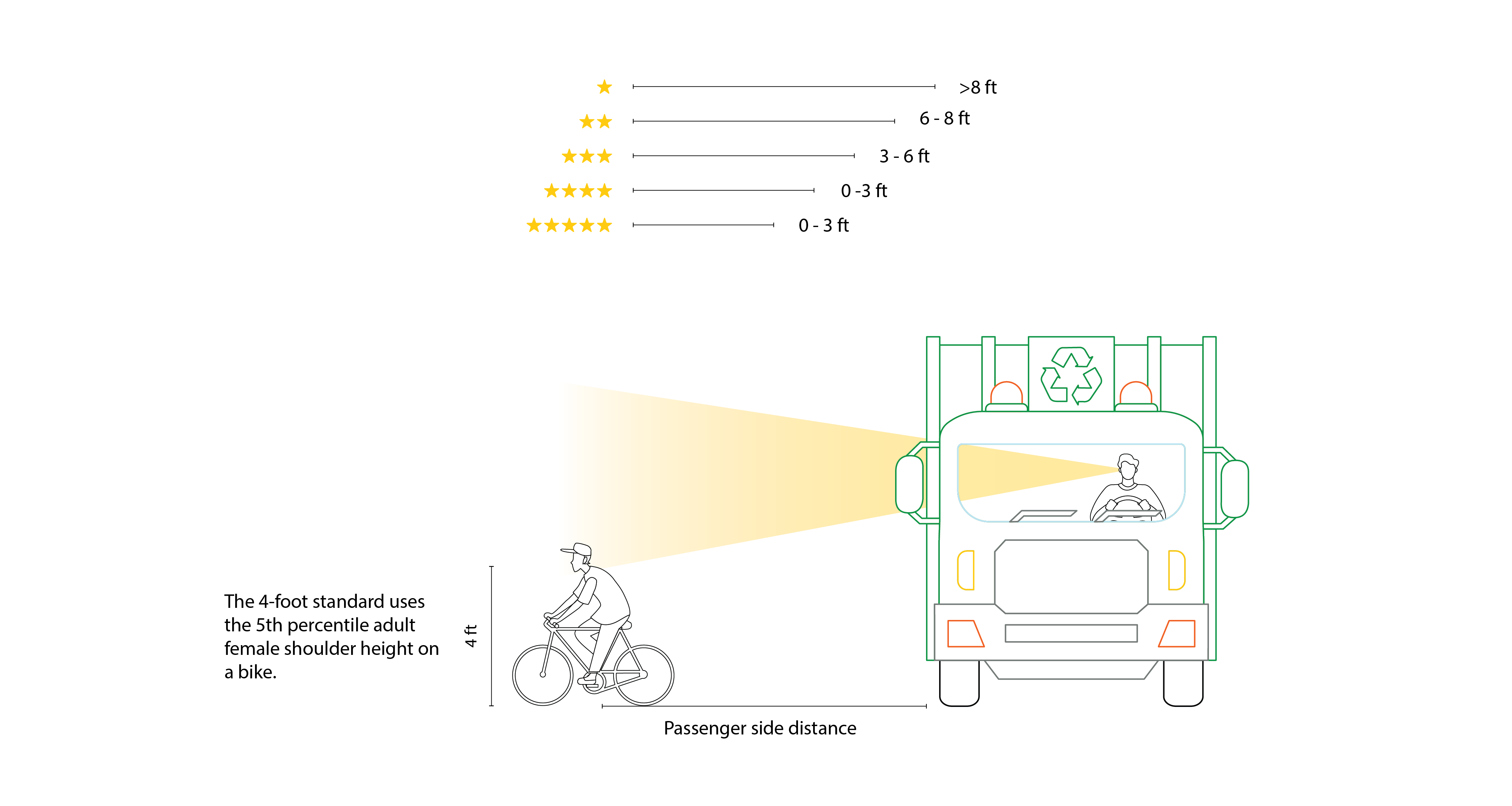Large Vehicle Safety
Large vehicles pose a special threat to people walking, biking, and rolling on city streets. We are finding ways to redesign trucks in our City fleet to make them safer.
Because of their size and design, large vehicles tend to have large blind zones. When there is a crash, it is often severe or fatal. From 2016 - 2022, three out of the six bicyclist deaths in Boston resulted from crashes with large vehicles. Understanding the risks posed by trucks and large vehicles will help make our streets safer and ultimately save lives.
To achieve this, we are adopting USDOT's Safe System Approach to help us eliminate fatal and severe crashes on our streets. The Safe Systems Approach acknowledges that people make mistakes and that our vehicles and our roadways should be designed so that mistakes are not fatal.
Watch: How smart vehicle design can make streets safer
This short video describes how the City of Boston is enhancing its fleet of large vehicles with new safety features and selecting trucks that are downsized and have smaller blind zones to protect pedestrians and cyclists.
Watch: What to know about trucks
This short video by CyclingSavvy is aimed at cyclists but is instructive for all road users.
Large Vehicle Designs
Three aspects of large vehicle designs make them difficult to operate safely on City streets:
- Large vehicles typically have large blind zones. Large hoods and small windows prevent drivers from seeing people who may be close to their vehicles. This is especially true for cyclists and small children. Vehicles that have smaller blind zones and that maximize the ability to see things directly ("Direct Vision") are inherently safer.
- Large vehicles often have large spaces between the front and rear wheels. People walking and biking can get caught and run over. Vehicles where these spaces are enclosed with bars or flat surfaces ("Side Guards") prevent this type of crash.
- Large vehicles are difficult to maneuver on tight City streets. This can lead to unexpected turns and sweeps. Choosing smaller vehicles that are optimized for City streets ("Downsizing") makes it easier for operators to drive safely and avoid collisions.
More information on Direct Vision, Side Guards, and Downsizing is provided below.
Ways to Make Vehicles Safer
Ways to Make Vehicles SaferWhat is Direct Vision?
Direct Vision is the ability of a driver to see firsthand outside their vehicle without the aid of indirect vision devices, such as mirrors or camera displays. Direct Vision enables eye contact between a driver and a vulnerable user (person walking, rolling, or cycling) near the vehicle; indirect vision generally does not. The blind zones of a vehicle are areas of the road that cannot be seen by a driver. Blind zones in the United States cause about one-fourth of truck-involved vulnerable user fatalities, typically during low-speed maneuvers.
How do we measure Direct Vision and Blind Zones?
For about a decade, entities have been exploring different rating systems in order to classify the safety of vehicles in cities. In 2021, Transport for London (TfL) and the Mayor of London implemented a Direct Vision Standard as part of the city’s Vision Zero approach. This first-of-its-kind standard applies to all vehicles over 12 tonnes (26,455 lbs), or Heavy Goods Vehicles, entering London and assigns a star rating from zero to five. The star rating is based on measurements of a driver’s Direct Vision through the vehicle's windows
In 2023, Together for Safer Roads hosted a one-day design challenge in New York City with U.S. DOT (Volpe), TfL, municipal, and industry representatives to establish a tool to rate visibility from the driver’s seat. The result was “the Cone Method,” which is a simple way to measure and rate Direct Vision in different types of vehicles using a tape measure and two traffic cones. Volpe and the City used the Cone Method to measure and rate the blind zones of a sample of Boston’s Public Works trucks, all of the fire department trucks, and 99% of Boston Public School buses and summarized the findings in a report titled Boston Blind Zone Safety Initiative.
To rate forward Direct Vision, we measured the visibility of a 3 foot tall cone representing the shoulder height of a 5th percentile elementary school-aged child in front of the vehicle. To rate passenger side Direct Vision, we measured the visibility of a 4 foot tall cone representing the shoulder height of a 5th percentile adult female on a bike to the right side of the vehicle. The ratings categories are summarized below.
| Rating | Forward Distance | Passenger Side Distance |
|---|---|---|
| 5 stars |
Elementary school children are visible less than 4 feet from the front of the vehicle. |
Adults and Elementary school children on a bike are visible less than 3 feet from the passenger side of the vehicle. |
| 4 stars |
Elementary school children are visible 4-6 feet from the front of the vehicle. |
Adults on a bike are visible less than 3 feet from the passenger side of the vehicle. |
| 3 stars |
Elementary school children are visible 6-8 feet from the front of the vehicle. |
Adults on a bike are visible 3-6 feet from the passenger side of the vehicle. |
| 2 stars |
Elementary school children are visible 8-10 feet from the front of the vehicle. |
Adults on a bike are visible 6-8 feet from the passenger side of the vehicle. |
| 1 star |
Elementary school children are visible more than 10 feet from the front of the vehicle. |
Adults on a bike are visible more than 8 feet from the passenger side of the vehicle. |
Side Guards are bars or flat surfaces designed to cover the space between the front and rear wheels of trucks, where cyclists or pedestrians can be trapped when a truck is moving. Tool boxes can also serve as Side Guards if they meet required specifications.
In 2014, the City of Boston became the first city in the nation to pass a Side Guard Ordinance that went into effect in 2015 requiring Side Guards on City-owned and City-contracted large vehicles (motor vehicles over 10,000 lbs and semi-trailers over 26,000 lbs), in addition to convex and crossover mirrors. Since then, cities around the country and at least one other state have taken the lead in requiring their government-owned and government-contracted fleets to be equipped with Side Guards. In 2024, MassDOT proposed similar regulations, as required under the 2022 Massachusetts Act to Reduce Traffic Fatalities.
Fleet owners and operators who drive on city streets should consider whether they should replace aging vehicles with smaller vehicles that are safer and better suited for driving in urban areas. As noted in a study on downsizing by USDOT Volpe and NACTO:
Vehicle downsizing presents opportunities to increase safety in three major ways:
1. By reducing the size and mass of vehicles operating on urban streets, thereby reducing their lethality when a crash occurs
2. By increasing the maneuverability of the vehicle and the driver’s ability to see the road, thereby reducing the likelihood that a crash will occur
3. By reducing the street width and turn radius required for vehicle passage, thereby increasing opportunities for cities to introduce life-saving, traffic calming street design treatments and increase protected space for pedestrians and cyclists
The average size and height of US vehicles has grown significantly over recent years. At the same time, the number of pedestrians dying in crashes each year has risen significantly. Studies have shown that there is a correlation between the two. The front-end height of a vehicle displays the most significant effect. Having a higher hood leading edge height increased pedestrian injury severity. “A 10 cm increase in the front-end height of a vehicle increases the risk of pedestrian death by 22%”. Pickup trucks are 291% more likely than a passenger car to kill a person on a bike in a crash.
Downsizing presents an opportunity to reverse the trend and make our streets safer.
RFI on Direct Vision (Issued 2024)
In Summer 2024, the City's Office of Emerging Technology sought information from large vehicle manufacturers and vendors about the sizes of blind zones and Direct Vision ratings in trucks they currently offer, as well as those in development.
We will use responses to help guide future vehicle purchases. We still welcome responses through this Google form. We are interested in both electric and non-electric vehicles and will offer to provide guidance and support on how to measure blind zones.




